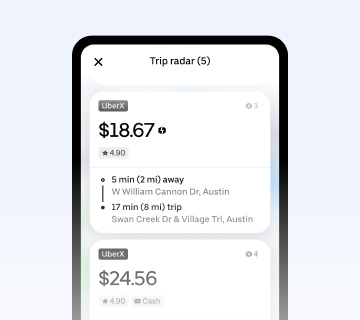Upfront pricing for drivers has launched in several cities, but what are drivers saying about this pilot program from Uber? Is Uber correct when they said driver earnings would go up, especially for short rides? We had RSG contributor Joe Pierce try out Uber’s new features and share his thoughts and earnings below.
As we reported recently, Uber rolled out upfront pricing for drivers in over 20 markets last week. Drivers are now shown the fare, expected trip duration and destination address when receiving a request.
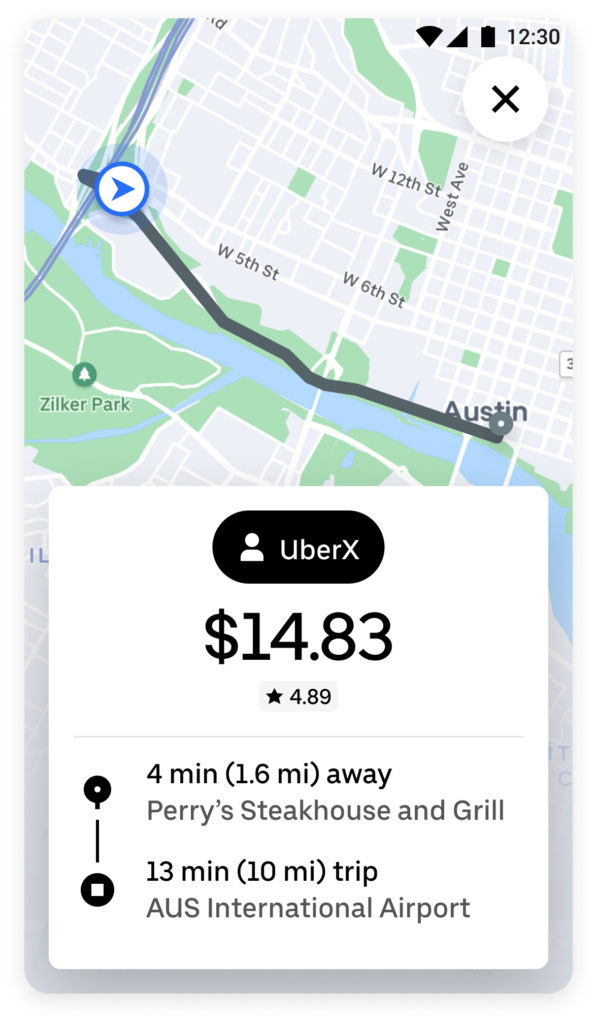
Fares are now calculated upfront before the ride happens; they are no longer calculated solely using time and distance rates as Uber has done since their inception.
I drive in Minneapolis, and we were one of the over 20 markets in which this program launched. I drove with these new features this week, and below I’ll share my experience, earnings, and how my earnings changed compared to my previous time and distance rates.
Upfront Pricing for Drivers – What is the Experience and Roll Out Like?
Coming into the week, I was excited to test these new features out. When I received my first request, it was a little overwhelming seeing all of the info, especially compared to the previous driver request screen that only showed the pickup location.
In addition, drivers are shown the mileage and expected duration of the trip, the dropoff location address, and the fare amount. You have to process all of that info within the 15 seconds you are allotted to accept the request.
Once I got the hang of it, the first thing I would look at is the pickup location mileage. I typically don’t like to accept any request that is more than 2 miles away.
For the most part, that is how I went about accepting all of my rides for the day, based mostly on how far away the pickup was. It was still great seeing the upfront fare as well as the dropoff location, but for most of the day, that info was just a bonus.
Mileage, Trip Duration and Dropoff Location Information: How Helpful Has it Been?
Occasionally, the mileage, trip duration and dropoff location info became crucial at certain points of the day. If there were times where I wanted to stick with shorter rides in order to achieve my quest bonus quicker, I would filter out longer rides. However, I relied on this additional information at a crucial point in my drive time: when I was ending my day.
When I want to head home for the day, I always enter destination mode a couple hours prior and typically give about 5 more rides. On Tuesday though, I was out in Farmington, which is an outer ring suburb 40 minutes south of downtown Minneapolis.
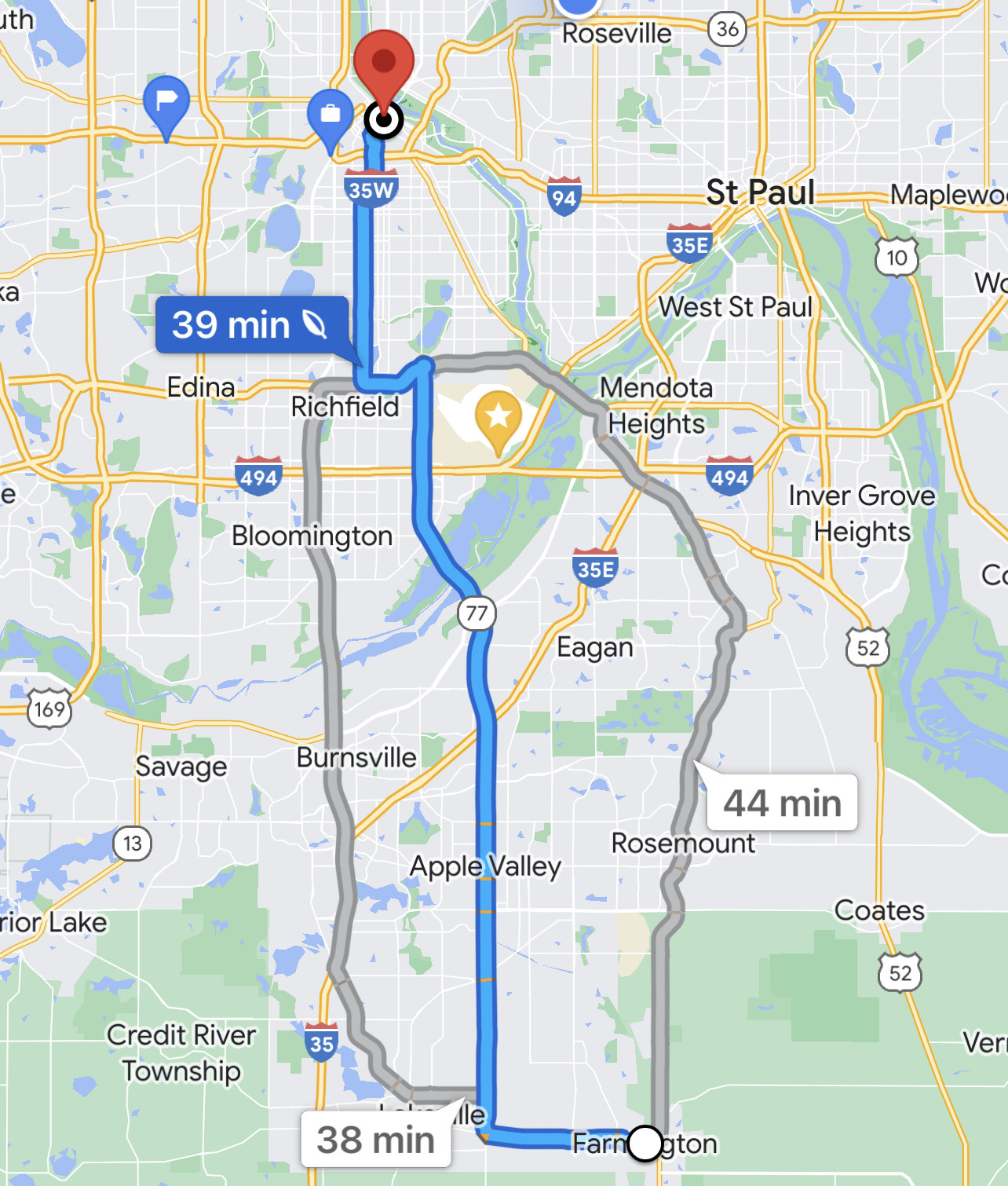
I had about 4 hours left in my day and decided to use destination mode to try and get closer to Minneapolis. Sure enough, I received a request that brought me directly to downtown Minneapolis.
Normally I wouldn’t have accepted this ride, as it was about 6 miles in the opposite direction, well outside my pickup threshold of 2 miles. But since I was able to see the dropoff address and fare, I accepted it.
Destination mode has always been a great feature, but even though previously you knew that a ride was bringing you closer to your destination, you had no idea where the ride was going or how long it was. Now that I have that info, it makes destination mode much more effective.
Also, as far as the trip duration and dropoff location, you aren’t shown on the map where the dropoff location is, so you have to guess based on looking at the address and duration of the trip info.
There were times, especially when receiving a back-to-back request while still completing a previous trip, where assessing this info on the go was difficult. I would sometimes just choose the stop trip requests option and then log back in once I completed my current ride.
Upfront Fare Information: How Useful is This for Drivers?
It’s great to see the upfront fare info, but I really didn’t use it much to filter out rides or assess the value of the ride. When requests are flying in, especially back-to-back requests, it’s hard to assess all of the information provided.
Again, I stuck with my usual piece of information to accept rides: how far away the pickup was. I might use the upfront fare info over time as I become more familiar with calculating on the fly how much a ride is worth. But right now it is just another piece of information to analyze.

Trip Radar
Uber also rolled out what they call Trip Radar. They describe it as “a new feature that gives you and other drivers a chance to see and select UberX requests happening nearby, extra options.”
Honestly, I have no idea how these are determined to be “extra options” and why they aren’t just sent out as live requests. Either way, it is nice to have additional options we can choose from at times.
I did only use it once as I wasn’t able to keep up with these. Often, I would select one immediately as it showed up and it would still be given to another driver.
When you do accept one and you are matched, you are immediately routed to that passenger. So again, I’m not sure how they choose these to be radar requests and not simply live requests.
Overall Thoughts on Upfront Fares and Drop Off Destination
I typically drive 10-11 hours on my “long driving” days, and I found the pickup mileage feature the most helpful out of all of the new features. However, I think the other features will be even more valuable to me on days where I just want to give a few short rides to complete a quest, or give a few long rides to make some good money in a short amount of time.
Overall, my experience with these features was fantastic and I love now having this additional info to provide even more flexibility.
My Earnings with Upfront Fares
Now for the most important topic, how did the upfront fares affect my earnings?
As mentioned, I really didn’t filter out any rides based on the upfront fare; I just accepted the majority of rides that were within two miles. This means my comparison to previous earnings vs. earnings with these new features is based on similar driving habits.
Two primary differences are I didn’t accept a few nearby pickups that were longer rides and I also accepted that one destination mode ride that was further away because it was worth it. However, this shouldn’t have changed my earnings drastically compared to my previous driving habits.
First, How are Upfront Fares Determined?
In the message that Uber sent out about upfront fares, this is some of their documentation on how fares will now be calculated:
- The fares you see will not be based on fixed time and distance rates alone. Instead, upfront fares can be based on several factors: some you know well, like base fare and time and distance rates, and some are new, like real-time demand at the destination.
- In general, fares on short trips will be going up and fares on long trips will be decreasing.
- If there’s unexpected traffic and the trip gets a lot longer, you’ll see an increased fare on the trip receipt. If there’s a change of address in the app while you’re on the trip, you’ll see an updated fare as you go.
- The surge value is also included in the fare you see up front, but it will also continue to show up on your trip requests.
- The only items that are not included in the upfront fare are wait time fees and tips, which continue to be added as soon as they’re paid out.
- Amounts related to Quests, Consecutive Trips, and other driver promotions will also continue to be added to your balance as they’re paid out.
One thing that stuck out to me was the “real-time demand at the destination” determining factor. This is essentially surge, yet surge still exists, so how do they determine whether a ride will have surge or they will just increase the fare amount?
This could be a way for them to eliminate surge amounts all together. Instead of seeing a specific surge amount on rides, it will just be tied into the fare. Sure, we still see those surge amounts now, but eventually that information may go away.
- Overall my earnings for the week on fares alone went up 5% compared to my time and distance earnings.
- The main thing that stuck out in the data: besides most minimum fare rides, I made more on every ride that was 5.5 miles or less. I gave 16 of these rides and earned about $19 more in total, an increase on average of over $1 per ride
As an example below are two trip detail screenshots of similar rides. The first one is a time and distance fare and the second is an upfront fare.
Both fares were 4.2 miles, and the duration of the upfront fare was actually 40 seconds less. Yet the upfront fare was $1.19 more.
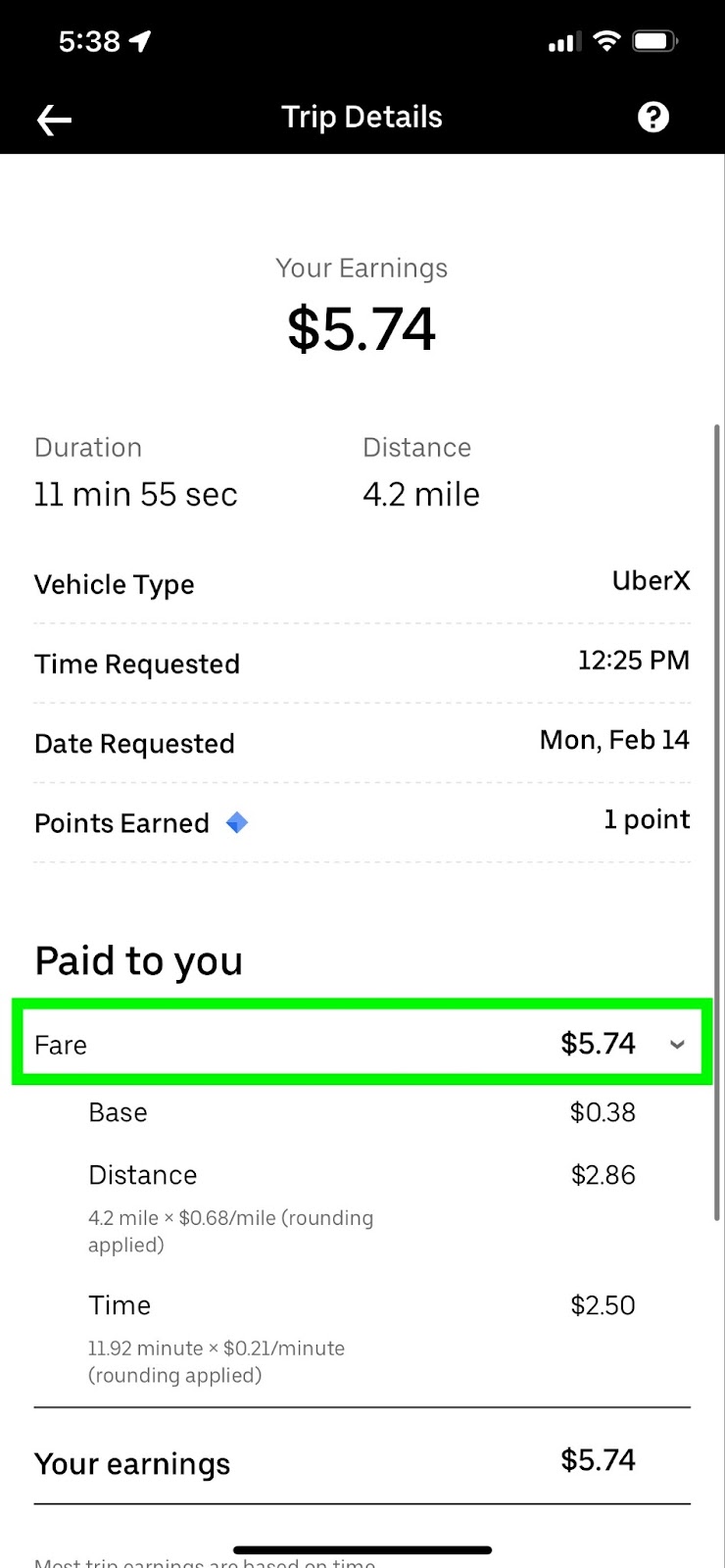
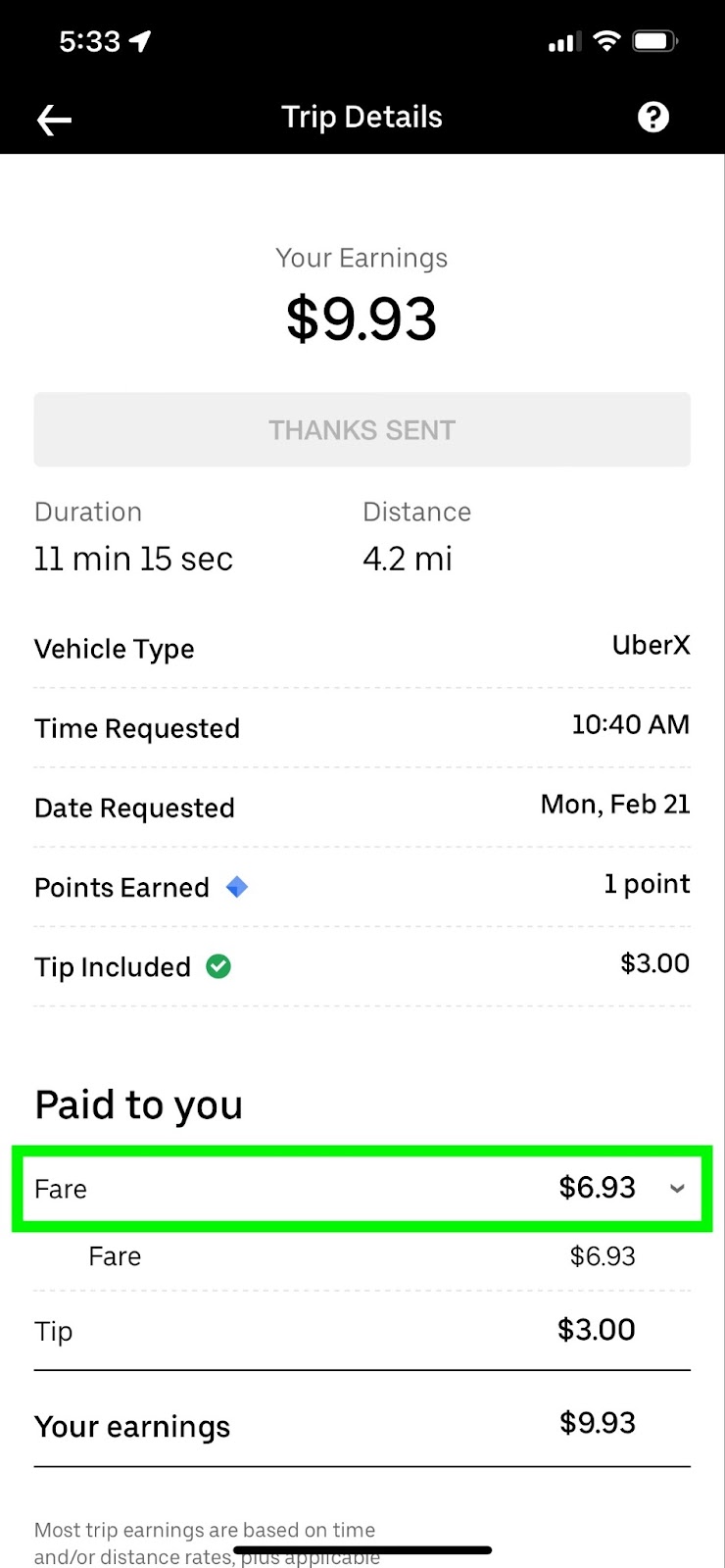
I also gave 26 rides over 5.5 miles and still had an increase of $5 total in earnings compared to my previous rates. However, 14 of those 26 fares were down. To contrast, only 2 of my 16 fares 5.5 miles or less were down.
Also, as far as surge, of my 16 rides less than 5.5 miles, 3 of those rides included surge, the upfront fare on 1 was down and 2 were up.
Of my 26 rides over 5.5 miles, 9 of them included surge, 5 were down and 4 were up. So as of now, I really don’t see Uber playing a lot with the surged upfront fares, which is a good sign.
Want to see how I calculated the change in fare earnings? Take a look at my spreadsheet here!
Takeaways for Drivers
According to my first week of driving with the new upfront pricing for drivers feature, accepting only rides 5.5 miles or less would ensure I maximize my earnings compared to my previous time and distance rates.
Now, I could implement this strategy going forward, but half of my rides were over 5.5 miles and those accounted for 70% of my earnings. Implementing this strategy would be the most efficient way to operate, but my earnings would be down because the longer rides are still the most lucrative financially.
I do love having all of this information on the request screen, but I don’t like that we no longer know exactly how our fares are calculated. It’s less transparent overall. Sure, my earnings were up 5% for the week, but what will they look like a year from now?
Uber can now play with the fares more based on driver behavior, and we don’t know specifically how they are calculating each fare. I hope they don’t slowly but surely decrease the upfront fares to improve their bottom line, but that is an outcome I could see from this change.
Also, I should mention that my previous per mile and per minute rates were slightly higher than most drivers because I signed up to drive back in 2014. This means most drivers would have seen an even bigger increase in earnings if they had the same upfront fares as me. It would be interesting to know if these upfront fares are the same regardless of driver tenure and status, which is another piece of information we no longer know.
One cool experiment for drivers in the same city: Get two drivers in the same room and see if the upfront fare changes at all when one declines.
Another thing to remember is you are paid the upfront fare regardless of the route that you take. So the days of choosing a longer route and earning more from the extra mileage no longer exist. Choosing the shortest route in terms of mileage will be the strategy to implement going forward in order to maximize revenue.
Overall, I’m just happy that my initial experience was positive, my earnings were up, and I have more information to allow me to better control my driving.
For those of you that have experienced these changes, what do you think? Were your earnings up or down? Did you change your driving habits? Leave a comment below and let us know.
-Joe @ RSG
